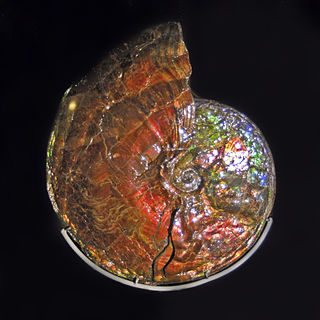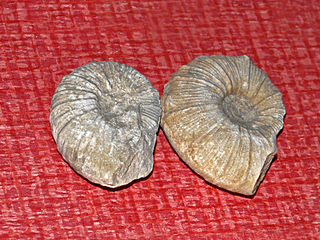Alocolytoceras is a lytoceratid ammonite with whorls that pass during growth from round to oval, rounded-quadrate, or compressed; with about 19 deep constrictions per whorl, with as many as 21 sharp ribs in between. The shell is evolute. All whorls are visible from either side.
Anagaudryceras is an extinct genus of ammonite from the later Cretaceous belonging to the Ammonoidea family Gaudryceratidae. Anagaudryceras has a moderately involute shell with a deep umbilicus and strongly ribbed outer whorl. Ribs are thick and rounded and cross over the venter uninterrupted.

Barremites is an ammonoid cephalopod genus belonging to the family Desmoceratidae, that lived during the Hauterivian and Barremian stages of the Early Cretaceous.

Ammonitina comprises a diverse suborder of ammonite cephalopods that lived during the Jurassic and Cretaceous periods of the Mesozoic Era. They are excellent index fossils, and it is often possible to link the rock layer in which they are found to specific geological time periods.

Normannites is a strongly ribbed evolute Middle Jurassic genus of ammonite included in the stephanoceratoid family Stephanoceratidae.

Placenticeras is a genus of ammonites from the Late Cretaceous. Its fossils have been found in Asia, Europe, North and South America.

Exiteloceras is an ammonite genus from the Late Cretaceous.

Juraphyllitidae is a family of Lower Triassic phylloceratin ammonites from Europe, North Africa, and Asia characterized by narrow, evolutely coiled shells, usually with coarse ventral ribbing on the body chamber. The first lateral saddles in the suture are diphyllic, with two terminal branches, others exposed sutural saddles are diphyllic or triphyllic, those covered by successive whorls being monophyllic. A few genera are more involute, with successive whorls partially embracing the flanks of the previous. All are compressed and a few lack ribbing.

Desmoceratoidea, formerly Desmocerataceae, is a superfamily of Cretaceous ammonites, generally with round or oval-whorled shells that are mostly smooth or weakly ribbed and rarely tuberculate, but commonly with constrictions. Regarded as monophyletic, the Desmocerataceae are derived from the Phylloceratidae, splitting off in the Early Cretaceous (Valanginian) and persisting to the end of the Maastrichtian.

Hoplitoidea, formerly Hoplitaceae, is a superfamily of mostly Upper Cretaceous ammonites comprising families united by a similar suture pattern with multiple similar elements that tend to decrease in size going toward the umbilicus, at the inner edge of any whorl, and which are typically in a straight line. Sutural elements are commonly ammonitic, but in some saddles and in others both saddles and lobes are smooth and undivided. Shells are variable in form, both ribbed, evolute forms and smooth, involute forms are included.

Engonoceratidae is a family of typically compressed, more or less flat sided and involute ammonites from the mid Cretaceous belonging to the Hoplitoidea. shells have flat sided outer rims ( venters), at least in some stage. Single or branching irregular ribs and variably placed tubercles may occur. Sutures have numerous auxiliary and adventive elements of similar form, in general radially arranged. Forwardly divergent saddles tend to be simple, without subdivision. Lobes, pointing apically, may be simple and undivided or may be frilled with short irregular serrations.

Placenticeratidae is an extinct family of mostly Late Cretaceous ammonites included in the superfamily Hoplitoidea, derived from the Engonoceratidae by an increase in suture complexity.
Blanfordiceras is a strongly ribbed, evolute ammonite included in the perisphinctacean family, Neocomitidae that lived during the latest Jurassic. The shell of Blanfordiceras is discoidal, with evolute coiling and all whorls visible so as to have a broad umbilicus. Exposed whorls are ornamented with strong ribbing that arises from the umbilicus, bifurcating on the outer flanks and extending onto the venter. In general form Blanfordiceras is similar to Berriasella, although with a more rounded whorl section.

Lytoceratidae is a taxonomic family of ammonoid cephalopods belonging to the suborder Lytoceratina, characterized by very evolute shells that generally enlarge rapidly, having whorls in contact but mostly overlapping very sightly, or not at all.
Brancoceratidae is a family of acanthoceratoid ammonites from the middle of the Cretaceous, recognized by their commonly evolute shells with round, oval, or quadrate whorls, strong ribs, usual ventral keels, and at least, umblical tubercles. The family is thought to be derived from the Desmoceratidae (Desmoceratoidea), perhaps from Silesitoides or some allied genus.
Bisatoceras is a late Paleozoic Ammonoidea, a member of the goniatitid family Bisatoceratidae.

Hauericeras is an ammonite genus from the Late Cretaceous that lived from the Coniacian to the late Maastrichtian, from about 90 to 66 mya. Fossils have been found in Europe, Russia, South Africa, Australia, India, Iraq, and in the United States.

Lobolytoceras is an extinct genus of ammonite in which only the inner whorls have large swollen ribs, later whorls have wrinkled growth lines which coarsen somewhat, near the aperture. The genus is known from the Lower Jurassic Toarcian of Europe. The type species L. siemensi (Denck) came from the Upper Toarcian of Germany.

Neocomitidae is a family of Lower Cretaceous ammonitids comprising genera with strongly ribbed evolute to smooth, fairly involute shells.

Holcodiscus is an extinct ammonite genus placed in the family Holcodiscidae. Species in this genus were fast-moving nektonic carnivores. The type species of the genus is Ammonites caillaudianus.














